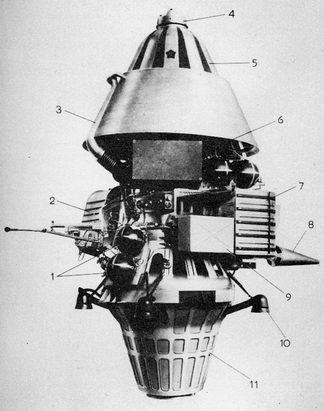Mission type Lunar orbiter Mission duration 89 days | COSPAR ID 1966-094A Spacecraft type E-6LF | |
 | ||
Launch mass 1,620 kilograms (3,570 lb) | ||
Luna 12 (E-6LF series) was an unmanned space mission of the Luna program, also called Lunik 12.
Luna 12 was launched towards the Moon from an Earth-orbiting platform and achieved lunar orbit on October 25, 1966. The spacecraft was equipped with a television system that obtained and transmitted photographs of the lunar surface. The photographs contained 1100 scan lines with a maximum resolution of 14.9-19.8 m. Pictures of the lunar surface were returned on October 27, 1966. The number of photographs is not known. Radio transmissions from Luna 12 ceased on January 19, 1967, after 602 lunar orbits and 302 radio transmissions.
Luna 12 was launched to complete the mission that Luna 11 had failed to accomplish—take high-resolution photos of the Moon’s surface from lunar orbit. Luna 12 reached the Moon on 25 October 1966 and entered a 133 x 1,200-kilometer orbit. The Soviet press released the first photos taken of the surface on 29 October—pictures that showed the Sea of Rains and the Aristarchus crater. Resolution was as high as 15 to 20 meters. Film was developed, fixed, dried automatically, and scanned for transmission to Earth. No further photos were ever released. After completing its main imaging mission, Luna 12 was put into a spin-stabilized roll to carry out its scientific mission, which was successfully fulfilled.
